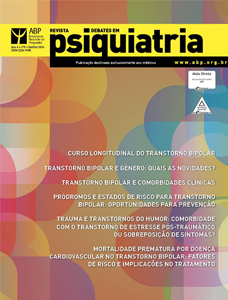Pródromos e estados de risco para transtorno bipolar: oportunidades para prevenção
DOI:
https://doi.org/10.25118/2236-918X-6-5-4Palavras-chave:
Bipolar, mania, pródromos, fases iniciaisResumo
O transtorno bipolar (TB) é uma doença psiquiátrica crônica e potencialmente grave. Nos últimos anos, pesquisas que focaram nas fases prodrômicas e iniciais do TB demonstraram que estratégias de detecção e intervenção precoces têm o potencial de atrasar, diminuir a severidade ou prevenir episódios completos do TB. Dessa forma, um novo caminho se apresenta para a clínica dos transtornos do humor, que passa não só a preocupar-se com o tratamento dos episódios de mania e depressão, como a buscar a detecção e o diagnóstico precoce e, fundamentalmente, a prevenção. O objetivo deste artigo é discutir dados da literatura sobre as fases iniciais do TB, os desafios da detecção precoce e as implicações desse enfoque para intervenções e manejo clínico antes ou logo após o desenvolvimento do primeiro episódio de mania, que marca, oficialmente, o início da doença.
Downloads
Métricas
Referências
Post RM, Denicoff KD, Leverich GS, Altshuler LL, Frye MA, Suppes TM, et al. Morbidity in 258 bipolar outpatients followed for 1 year with daily prospective ratings on the NIMH life chart method. J Clin Psychiatry. 2003;64:680-90; quiz 738-9.
Murray CJ, Lopez AD. The global burden of disease: a comprehensive assessment of mortality and disability from diseases, injuries, and risk factors in 1990 and projected to 2020. Cambridge: Harvard University; 1996.
Kapczinski F, Vieta E, Andreazza AC, Frey BN, Gomes FA, Tramontina J, et al. Allostatic load in bipolar disorder: implications for pathophysiology and treatment. Neurosci Biobehav Rev. 2008;32:675-92.
Berk M, Conus P, Lucas N, Hallam K, Malhi GS, Dodd S, et al. Setting the stage: from prodrome to treatment resistance in bipolar disorder. Bipolar Disord. 2007;9:671-8.
Kapczinski F, Dias VV, Kauer-Sant’Anna M, Frey BN, Grassi-Oliveira R, Colom F, et al. Clinical implications of a staging model for bipolar disorders. Expert Rev Neurother. 2009;9:957-66.
Berk M, Hallam KT, McGorry PD. The potential utility of a staging model as a course specifier: a bipolar disorder perspective. J Affect Disord. 2007;100:279-81.
Berk M, Kapczinski F, Andreazza AC, Dean OM, Giorlando F, Maes M, et al. Pathways underlying neuroprogression in bipolar disorder: focus on inflammation, oxidative stress and neurotrophic factors. Neurosci Biobehav Rev. 2011;35:804-17.
Brietzke E, Mansur RB, Soczynska JK, Kapczinski F, Bressan RA, McIntyre RS. Towards a multifactorial approach for prediction of bipolar disorder in at risk populations. J Affect Disord. 2012;140:82-91.
McGorry PD, Yung AR. Early intervention in psychosis: an overdue reform. Aust N Z J Psychiatry. 2003;37:393-8.
McGorry PD, Hickie IB, Yung AR, Pantelis C, Jackson HJ. Clinical staging of psychiatric disorders: a heuristic framework for choosing earlier, safer and more effective interventions. Aust N Z J Psychiatry. 2006;40:616-22.
Taylor M, Bressan RA, Pan Neto P, Brietzke E. Early intervention for bipolar disorder: current imperatives, future directions. Rev Bras Psiquiatr. 2011;33:s197-212.
Bechdolf A, Ratheesh A, Wood SJ, Tecic T, Conus P, Nelson B, et al. Rationale and first results of developing at-risk (prodromal) criteria for bipolar disorder. Curr Pharm Des. 2012;18:358-75.
Singh MK. Is there validity to the bipolar prodrome? J Clin Psychiatry. 2015;76:e655-6.
Rios AC, Noto MN, Rizzo LB, Mansur R, Martins FE Jr, Grassi-Oliveira R, et al. Early stages of bipolar disorder: characterization and strategies for early intervention. Rev Bras Psiquiatr. 2015;37:343-9.
Passos IC, Jansen K, Kapczinski F. Developmental staging models in bipolar disorder. Int J Bipolar Disord. 2015;3:33.
Scott J. Bipolar disorder: from early identification to personalized treatment. Early Interv Psychiatry. 2011;5:89-90.
Correll CU, Hauser M, Penzner JB, Auther AM, Kafantaris V, Saito E, et al. Type and duration of subsyndromal symptoms
in youth with bipolar I disorder prior to their first manic episode. Bipolar Disord. 2014;16:478-92.
Goetz M, Novak T, Vesela M, Hlavka Z, Brunovsky M, Povazan M, et al. Early stages of pediatricbipolar disorder: retrospecti ve analysis of a Czech inpati ent sample. Neuropsychiatr Dis Treat. 2015;11:2855-64.
Noto MN, Noto C, Caribe AC, Miranda-Scippa Â, Nunes SO, Chaves AC, et al. Clinical characteristi cs and infl uence of childhood trauma on the prodrome of bipolar disorder. Rev Bras Psiquiatr. 2015;37:280-8.
Bellivier F, Golmard JL, Rietschel M, Schulze TG, Malafosse A, Preisig M, et al. Age at onset in bipolar I aff ecti ve disorder: further evidence for three subgroups. Am J Psychiatry. 2003;160:999-1001.
Kessler RC, Berglund P, Demler O, Jin R, Koretz D, Merikangas KR, et al. The epidemiology of major depressive disorder: results from the Nati onal Comorbidity Survey Replicati on (NCS-R). JAMA. 2003;289:3095-105.
Egeland JA, Hostett er AM, Pauls DL, Sussex JN. Prodromal symptoms before onset of manicdepressive disorder suggested by fi rst hospital admission histories. J Am Acad Child Adolesc Psychiatry. 2000;39:1245-52.
Fergus EL, Miller RB, Luckenbaugh DA, Leverich GS, Findling RL, Speer AM, et al. Is there progression from irritability/dyscontrol to major depressive and manic symptoms? A retrospecti ve community survey of parents of bipolar children. J Aff ect Disord. 2003;77:71-8.
Rucklidge JJ. Retrospecti ve parent report of psychiatric histories: do checklists reveal specifi c prodromal indicators for postpubertalonset pediatric bipolar disorder? Bipolar Disord. 2008;10:56-66.
Skjelstad DV, Malt UF, Holte A. Symptoms and signs of the initi al prodrome of bipolar disorder: a systemati c review. J Aff ect Disord. 2010;126:1-13.
Birmaher B, Axelson D, Goldstein B, Strober M, Gill MK, Hunt J, et al. Four-year longitudinal course of children and adolescents with bipolar spectrum disorders: the Course and Outcome of Bipolar Youth (COBY) study. Am J Psychiatry. 2009;166:795-804.
Bechdolf A, Nelson B, Cott on SM, Chanen A, Thompson A, Kett le J, et al. A preliminary evaluati on of the validity of at-risk criteria for bipolar disorders in help-seeking adolescents and young adults. J Aff ect Disord. 2010;127:316-20.
Bechdolf A, Ratheesh A, Cott on SM, Nelson B, Chanen AM, Bett s J, et al. The predicti ve validity of bipolar at-risk (prodromal) criteria in help-seeking adolescents and young adults: a prospecti ve study. Bipolar Disord. 2014;16:493-504.
McNamara RK, Strawn JR, Chang KD, DelBello MP. Interventi ons for youth at high risk for bipolar disorder and schizophrenia. Child Adolesc Psychiatr Clin N Am. 2012;21:739-51.
Bauer M, Juckel G, Correll CU, Leopold K, Pfennig A. Diagnosis and treatment in the early illness phase of bipolar disorders. Eur Arch Psychiatry Clin Neurosci. 2008;258:50-4.
Downloads
Publicado
Como Citar
Edição
Seção
Licença

Este trabalho está licenciado sob uma licença Creative Commons Attribution-NonCommercial 4.0 International License.
Debates em Psiquiatria permite que o (s) autor (es) mantenha(m) seus direitos autorais sem restrições. Atribuição-NãoComercial 4.0 Internacional (CC BY-NC 4.0) - Debates em Psiquiatria é regida pela licença CC-BY-NC
































